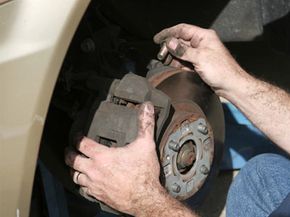If the term "brake bleeding" conjures up images of a clean, contented person stepping on a brake pedal while another grumpy, dirty, frustrated person yells, "Push down!" from under the car, your image would be correct. Brake bleeding is a general repair job that many people would not enjoy, but it is something that must be done throughout the lifespan of an automobile.
Most brakes should be bled every two or three years to keep your brake system at optimum performance. [source: Allen] Small amounts of air can become trapped in the brake line, creating a spongy feeling when you step on the pedal. If large amounts of air enter the brake line, your vehicle can suffer a complete braking failure.
Advertisement
So how does air get in there? Air can sneak into your brake system during certain types of servicing or if there is a leak. Air can also enter the line for less obvious reasons like worn pads (or an impatient driver who constantly slams on the brakes).
When you bleed brakes, you are removing the air from the line. This helps ensure that your brakes are in top condition, and that you won't drive off the edge of a cliff like some tragic characters do in the movies. There are three methods of bleeding brakes:
- Vacuum pumping
- Pressure pumping
- Pump and hold
If you find that your master cylinder is low on fluid, you should investigate the problem. The entire braking system is a closed system, meaning no fluid should ever escape. If you are low, finding and fixing the leak should be your first order of business.
In this article, we'll explore each method. We'll start with the supplies needed to get your favorite car back in shape. Start your engines! Then pull into the garage, and shut them off again.
